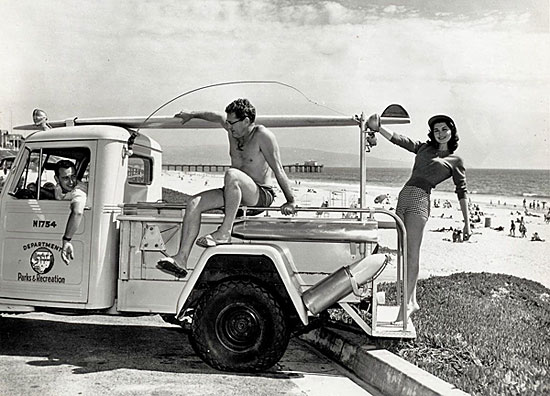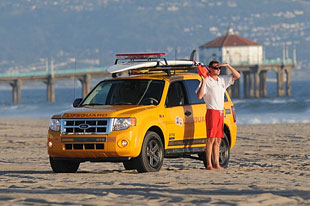
Bathing beauties were still posing on county lifeguard trucks in 1959. Photo/LA County Lifeguard Assn.
Summer isn’t summer in Los Angeles County without the bright yellow vehicles of the beach patrol.
“Iconic” is how Chief Lifeguard Mike Frazer described them last week as the Board of Supervisors gave the Department of Beaches and Harbors authority to sign a proposed agreement to take ownership of the fleet’s latest additions—45 custom-built Ford Escape hybrids that the county has leased since 2008. Under that proposed agreement, Ford Motor Co. would continue to advertise itself as the “Official Vehicle Sponsor” of the L.A. County beach lifeguards. So far, however, Ford has not agreed to a transfer of ownership.
Outfitted with state-of-the-art rescue equipment, the vehicles have saved not only lives but also more than $267,000 a year in fuel costs. “We’ve come a long way,” Chief Frazer says.
In fact, as the photo gallery below shows, beach rescue vehicles have come farther than Southern Californians might imagine. And to look back at their history is to dip into the region’s evolving—and sometimes dangerous—relationship with the beach.
Arthur Verge, an El Camino College history professor and veteran county lifeguard, notes that there was a time, not so long ago, when Southern Californians regarded the ocean as a frightening place that was best admired from afar. “Drownings were sadly common,” Verge says, adding that those who did go into the water often had no idea how to swim or how to get out of the powerful rip-currents that swept them out to sea in their heavy wool bathing outfits.
Professional ocean lifeguards didn’t even exist here until the early 1900s, when the City of Long Beach and real estate developers Abbot Kinney and Henry Huntington began paying “lifesavers” to reassure tourists outside the Long Beach Plunge and to promote the then-new developments of Venice and Redondo Beach.
Notably, Kinney and Huntington turned in 1907 to George Freeth, a celebrated Hawaiian surfer who not only trained L.A. County’s first generation of lifeguards but also pioneered rescue response.
“While fire departments were using horse-drawn rigs,” Verge says, “George Freeth, as early as 1912, was patrolling the beaches of Redondo, Hermosa and Manhattan Beach with a motorcycle, carrying a metallic rescue can in a special sidecar.”
Other early lifeguards were more low-tech.
“Santa Monica’s first lifeguard, ‘Cap’ Watkins, patrolled the beach on horseback,” Verge notes. “And George Wolf, the first Los Angeles city lifeguard, rode back on forth from Venice to El Segundo on a bike.”
By the late 1920s, both the city and county had lifeguards and trucks that ferried their gear along the boardwalks. That gear was stretched thin in the 1930s as the county lifeguards took over the beaches in the economically struggling South Bay.
“We didn’t get any new vehicles until the late ‘40s because World War II was on,” recalls Cal Porter, an 88-year-old retired county lifeguard and Malibu surfer. “If somebody had a bad rescue…we’d jump into this old 1933 International we had and head down Pacific Coast Highway. We’d be going as fast as we could, lights and sirens going—but all the other cars would be passing us.”
With wartime came the 4-wheel-drive jeep, developed by Willys-Overland Motors for the U.S. Army. The Willys allowed lifeguards for the first time to skip the boardwalk and drive directly across the sand. The jeeps were redeployed onto county beaches in the late 1940s; some remained in use for the next twenty years.
By the 1960s, the county had a fleet of Ford trucks with special racks for lifesaving equipment. Beaches filled with Baby Boomers and, occasionally, the products of the era’s experimental mood: In 1970, the county bought two customized dune buggies from the designer Meyers Manx. “But they didn’t work,” Verge says. “Sand would get into the carburetor.”
Lifeguard operations consolidated in the mid-1970s under the county, which by 1975 had the world’s largest lifeguard organization—a distinction that brought marketing opportunities. Among them was the chance for car companies to become the “official” rescue vehicle supplier to the now renowned L.A. County beach lifeguards.
Kerry Silverstrom, chief deputy director of the county Department of Beaches and Harbors, says that in 1986, Nissan and the beach lifeguards signed an agreement. “They got name recognition, ad copy and the ability to say they’re the official vehicle of the County beaches,” she notes, “and we got to use their vehicles for free.”
Nissan’s deal—releasing 30 chrome yellow 4×4 King Cab lifeguard trucks and six light pewter Stanza wagons onto the county beaches—lasted until 1994, when Ford won the contract. Nissan got it back in 1999, but Ford made another comeback with the hybrid SUVs in 2008.
Frazer says lifeguards were accustomed to pickup trucks with gas engines, and concerned that sand might damage hybrids. “But one of our missions is to protect the environment, so we said, ‘Let’s see if this works.’ ”
He says the results have been striking.
“The visibility is amazing and the turning radius is almost twice what we had, so we can navigate crowds better,” he says. “It has traction even in places like Point Dume, which has a steep sloping beach. “
Silverstrom says the relationship with Ford has been a financial and environmental lifesaver as the economy and the Internet have made branding rights a tougher sell at beaches. As for the next generation of vehicles, Frazer says the lifeguards “continue to look at all the options.” After all, only 100 years have passed since George Freeth rode to the rescue on his motorbike.
Posted 5/9/12















